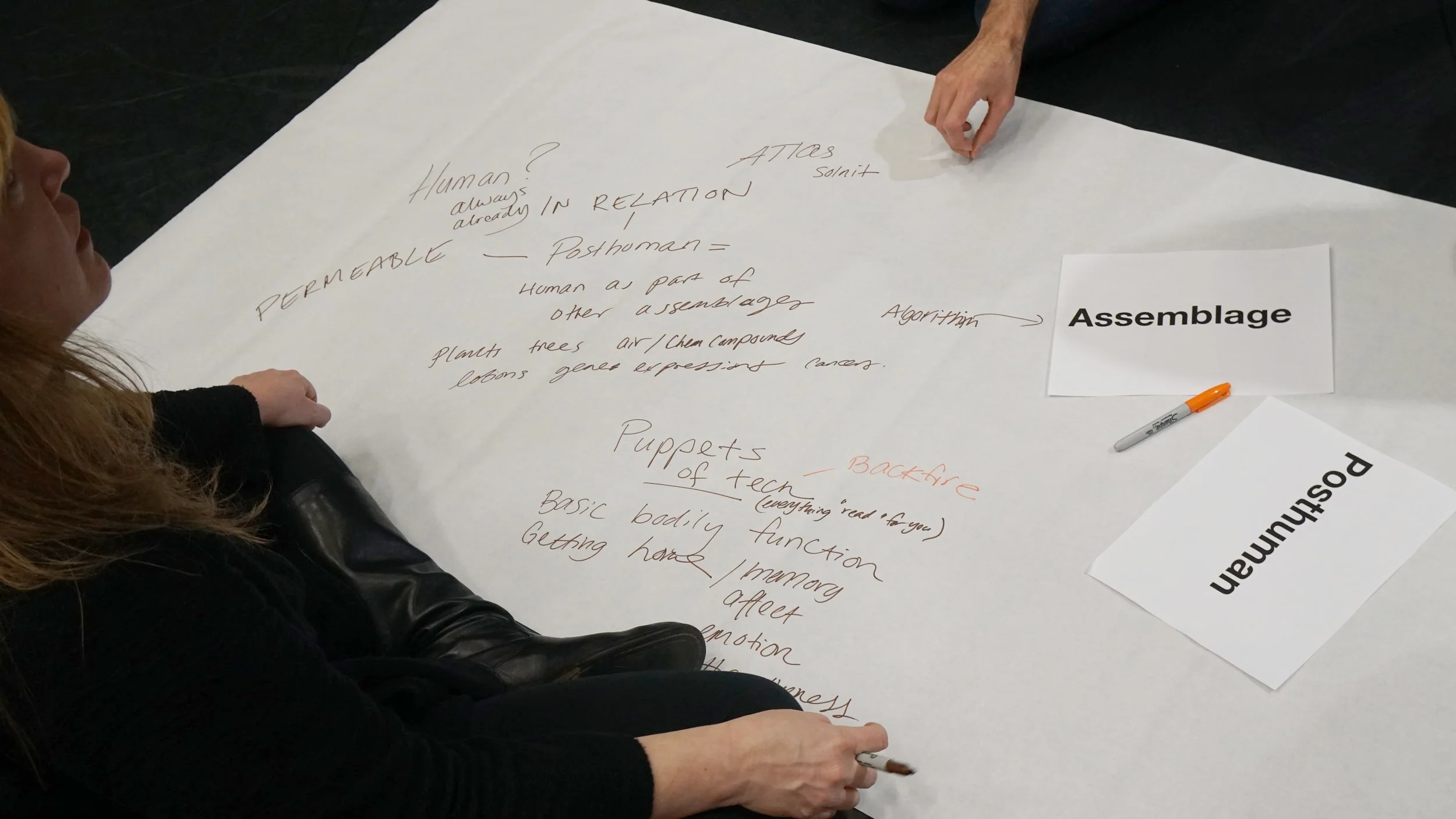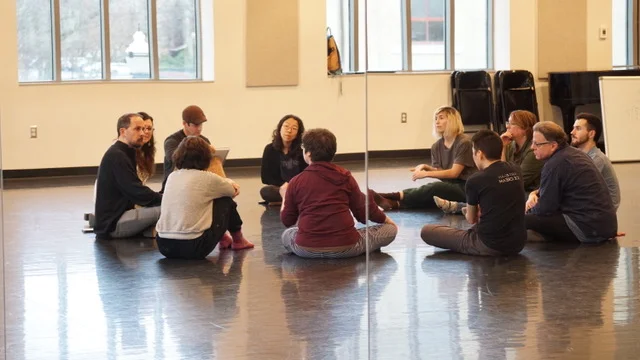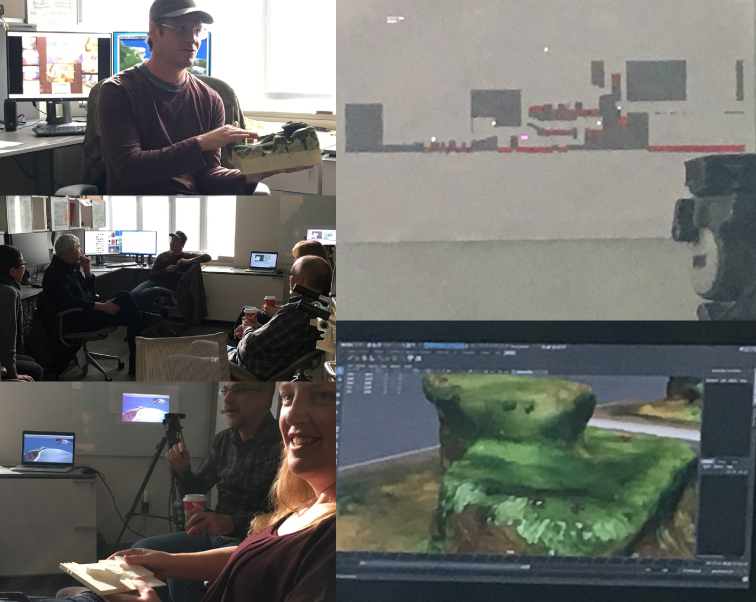On October 27, 2017 Norah Zuniga Shaw hosted a writing jam in relation to this years theme on Wellbeing entitled Beautiful Complexity. This jam included a movement storm which is a score for generating ideas, developing language and getting into a shared space of embodied discovery. Below are selected reflections from participants Candace Stout and Ben McCorkle.
Candace Stout, Department of Arts Administration, Education, and Policy
Last week Norah invited me to a sandbox, along with our good colleagues Peter Chan, Ben McCorkle and Rick Livingston. I envisioned a think-tank affair, four of us seated around a table, Norah flipping a tablet, noting concept gems, diagrams and ah-ha moments. Things, however, weren't that way and at the outset, I was uneasy. Maybe it was the Starbucks venti espresso. Maybe it was the walk through the ACCAD supply closet culminating in a rubberized room, or the almost audible monastic soundtrack infusing that space. Whatever was that initial instinct [over-caffeination or sedimented institutional expectations], it dissipated in finding, in Toni Morrison's words, "the friends of my mind." Among the piles of yellow paper scattered on the floor, the incidental flip charts at the edge of the room, and in the layers of journal articles that Norah placed on tables, I found compelling relevance. There were key words, incisive phrases, and insistent commentaries-expressions resonating with and informing my own humanizing epistemology and practice, and importantly, that of my grad students in the most consequential ways. Humanizing research works toward connection and disruption, relational, dialogic, consciousness-raising for self and others. It is a mind-set, strategies animating and probing performance and experience, activating sympathetic and empathic awareness. Graduate researchers in my writing seminar use the virtual to examine, understand and impact the material-the real. They are committed to the work of
meditation for well-being, healing, coping with the human condition; understanding the nature and import of embodied knowing; using arts performance as connection in public spaces; using narrative ways of knowing for the researcher-self and those with whom meaning is created. Multimodality in knowing and relating are primary in what they do. Research toward connection, disruption, and resolve. Thank you Rick, Peter and Ben for this collaboration. Thank you Norah for sharing this inspiring box of sand.
Ben McCorkle, Department of English
I’d like to play with a scaled-down version of a much larger cloud of ideas that I have percolating in my head that deals with generating creative ideas by exploring connections between binaries, closed systems, things that seem irreparably divisive, unconnected, or incapable of change.
The jam activity today was designed with a particular purpose in mind: to generate ideas that will guide the HT collective’s thinking about the theme of well-being might eventually help give shape to some future artifact or text such as a journal article, blog post, etc. After debriefing, we first engaged in a 20-minute period of “graze, gather, raise.” After, we shifted to the atomizing phase, exploding a concept out into multiple areas, then shared our results with one another, and then left to produce things like this one I’m writing now
Yes, I know, we were all there—your recollection is probably a lot more granular than this account is. My point, though, is that everyone talked about the *process* of this activity—we acknowledged it *as its own thing* rather than the thing that leads to the thing (i.e., that piece of writing, etc. that we might generate down the line). Process and product—this is how we typically butcher the meat. But in this case, the process itself can be seem a type of product, a thing in and of itself, or at least the anticipatory echo of products-to-be. Here, I find myself contemplating what that means in terms of the HT project and how it relates to this theme of well-being. This process-as-product, which engaged the entire sensorium, our sense of proprioception, our sense of care as we moved through the space and manipulated its contents, opens up a space of possibility as a potential product that addresses our idea of well-being.
For example, I can imagine this activity as an immersive VR program designed to help users generate their own creative ideas that allows them to map, move, (re)place text, images, etc., and especially allow for positive collaborative interactivity. Or maybe some sort of meditation training app that, by moving words rapidly, playfully, and constantly through a virtual or augmented space, creates that mantra-like phenomenon of semantic satiation that often accompanies transcendent states (“care, care, care, care, care, …”). Or maybe an application that would help with conflict mediation in some way by creating a dynamically manipulable, shared virtual space where users would work with material in a way that would bring about resolution through cooperative play (okay, this one is a little half-baked, but I think there might be something there). In these cases, the underlying idea is the same: focusing on today’s process itself as the wireframe around which we build possible products aimed at designing technological solutions to the problems impeding our well-being…










